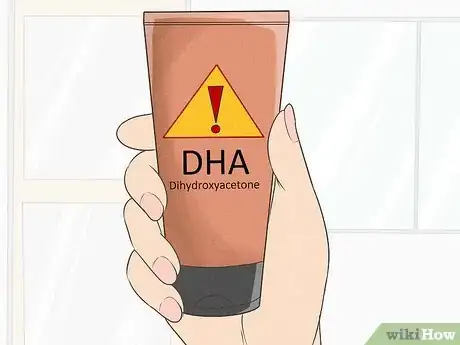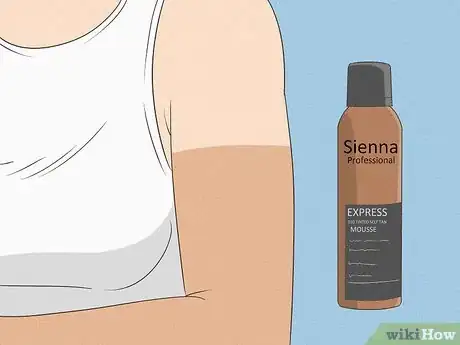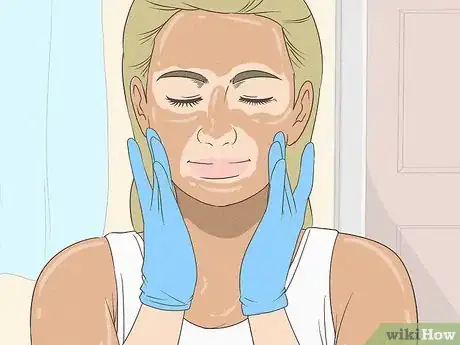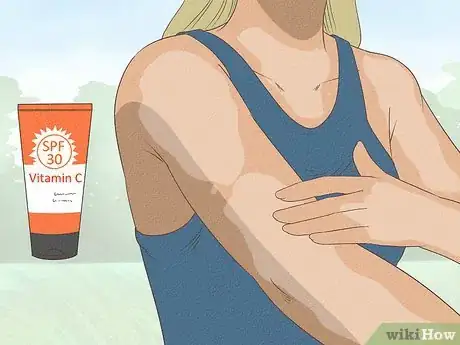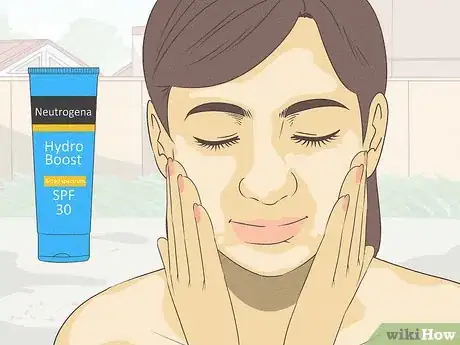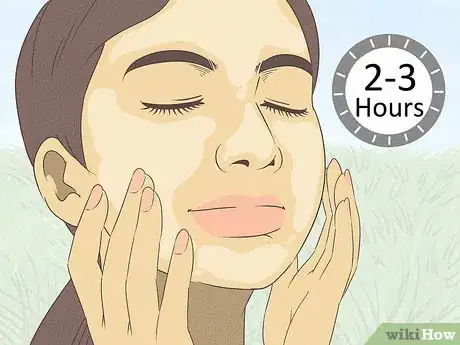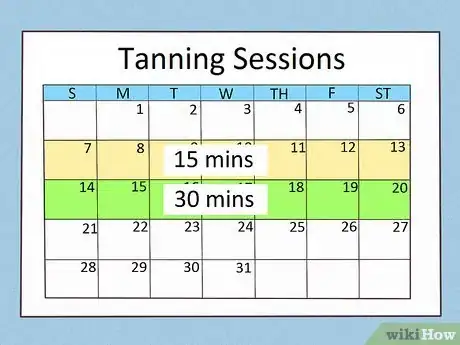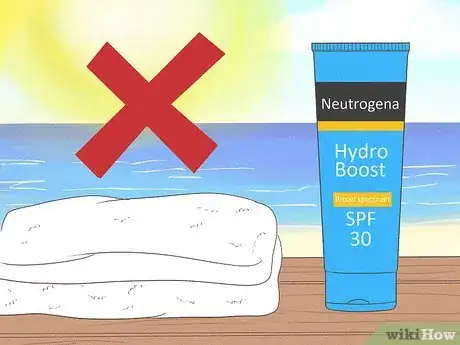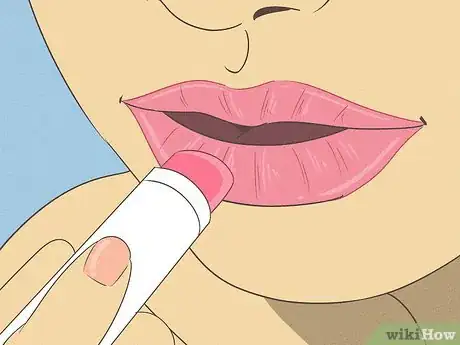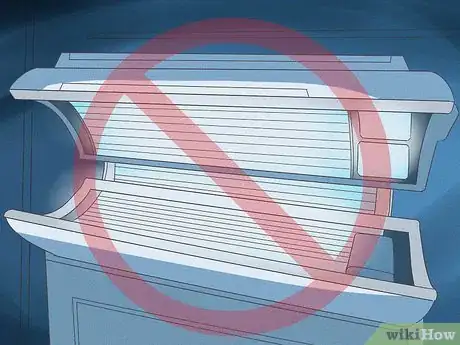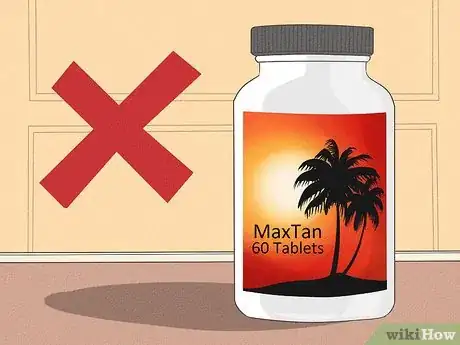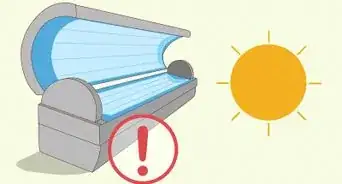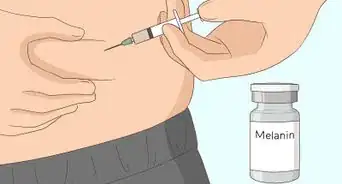This article was co-authored by Margareth Pierre-Louis, MD. Dr. Margareth Pierre-Louis is a board certified Dermatologist and Dermatopathologist, Physician Entrepreneur, and the Founder of Twin Cities Dermatology Center and Equation Skin Care in Minneapolis, Minnesota. Twin Cities Dermatology Center is a comprehensive dermatology clinic treating patients of all ages through clinical dermatology, cosmetic dermatology, and telemedicine. Equation Skin Care was created to provide the best in evidence-based, natural skin care products. Dr. Pierre-Louis earned a BS in Biology and an MBA from Duke University, an MD from the University of North Carolina at Chapel Hill, completed a residency in dermatology at the University of Minnesota, and completed a dermatopathology fellowship at Washington University in St Louis. Dr. Pierre-Louis is board certified in dermatology, cutaneous surgery, and dermatopathology by the American Boards of Dermatology and Pathology.
There are 18 references cited in this article, which can be found at the bottom of the page.
wikiHow marks an article as reader-approved once it receives enough positive feedback. In this case, several readers have written to tell us that this article was helpful to them, earning it our reader-approved status.
This article has been viewed 737,236 times.
Every fair-skinned person knows just how difficult getting a tan can be. Light skin is more susceptible to the sun's damaging ultraviolet (UV) rays, causing it to burn much faster than darker skin. Not only is this damage painful and unsightly, but it can also lead to long-term health problems like skin cancer.[1] Luckily, there are still many ways for fair-skinned people to achieve a great tan for the summer.
Steps
Using Sunless Tanners
-
1Consider possible health risks. While doctors generally recommend sunless tanning as a safer alternative to UV exposure, these products are not without drawbacks. The active ingredient in most sunless tanners is called dihydroxyacetone (DHA). DHA interacts with amino acids in your skin's outer layer to cause a browning effect. Some scientists have shown DHA to cause DNA damage at high concentrations.[2] However, DHA is safe to use on skin where it is mostly absorbed by dead cells. Minimize your risks by avoiding spray-on products that may be inhaled and rinsing off excess tanner from your hands. Additionally, some individuals are allergic to this chemical, which can result in contact dermatitis.[3]
-
2Pick the right sunless tanner. For pale skin, buy the lightest shade of self-tanner your product of choice comes in. Darker tanners contain higher concentrations of DHA. A too-dark sunless tan will look orange and unnatural on a person with naturally light skin.Advertisement
-
3Exfoliate your skin. Removing excess dead skin before applying sunless tanner will help the color to last longer. Scrub gently with a washcloth or loofah. Pat your skin dry with a towel.[4]
-
4Massage the self-tanner into your skin. Avoid areas near your eyes, nose, and mouth. There are two main ways you can avoid discoloring your palms:
- Wear exam gloves during application.
- Apply the tanner in sections (arms, legs, torso, face) and wash your hands between each section.[5]
-
5Allow the self-tanner to dry. Wait at least 10 minutes before getting dressed. Wait at least six hours before bathing or swimming. Re-apply the tanner daily until your skin reaches your desired hue.[6]
-
6Minimize sun exposure for 24 hours after using a product with DHA. If you must be in the sun, wear sunscreen. While DHA provides transient UV protection, it may also temporarily boost the production of UV-induced reactive oxygen species. These molecules are a major contributor to sun damage, negatively impacting your skin's health and appearance.[7] [8]
Tanning Outside
-
1Massage sunscreen into all exposed skin 30 minutes before going outside. Buy a sunscreen that offers "broad-spectrum" protection, which will guard against both UVA and UVB rays. Dermatologists recommend a minimum SPF of 15, but individuals with very fair skin will likely need one with a higher rating.[9]
-
2Reapply sunscreen as necessary. Most sunscreen manufacturers advise to reapply every 2 to 3 hours.[10] However, earlier reapplication is often necessary, especially for people with fair skin. Apply more sunscreen 15 to 30 minutes after any activities that may remove the sunscreen from your skin, such as sweating, swimming, or toweling off.[11]
-
3Tan in multiple short sessions over many days, weeks, or even months. Start out sunning yourself for only about 15 minutes each day. After about a week, work your way up to a maximum of 30 minutes. Stop sessions sooner than planned if you start to burn. While many think that longer, more intense tanning sessions are the quickest way to a great tan, this is not generally true, especially for fair-skinned people. The optimal amount of time in the sun to stimulate melanin production without damaging your skin is only about 30 minutes.[12]
-
4Avoid tanning when the sun is at its brightest. Damaging UV rays are at their peak between the hours of 10 am and 4 pm. Instead, tan in the early morning or late afternoon. If you must tan at peak hours, be sure to wear a sunscreen with a high SPF.[13]
-
5Wear a hat and sunglasses. A wide-brimmed hat will protect your sensitive scalp while letting some diffuse light in to tan your face. Sunglasses will protect your eyes from sun damage, which can lead to cataracts and other vision problems. Don't fall asleep with either on to avoid embarrassing tan (or burn) lines.[14]
-
6Protect your lips with SPF lip balm. Your lips can burn just as easily as the rest of your skin. The sun can also dry them out quickly, leading the painful chapped lips. SPF lip balms offer protection against both types of damage.[15]
Staying Safe
-
1Remember that there is no completely safe way to sun tan. Even cautious tanning may lead to health problems down the line. Dermatologists assert that any UV-induced changes to your natural skin tone indicate damage.[16] Be sure to weigh the cosmetic benefits against long-term health risks.
-
2Keep in mind any medications you are taking. Certain medications, such as retinoids and some antibiotics, can dramatically increase your skin's susceptibility to sun damage. Before you tan, carefully read all warning labels and literature for your medications, vitamins, and health supplements. Talk to your doctor or pharmacist if you have any questions.[17]
- If you are taking any unprescribed dietary supplements or herbal medicines, it is very important to do your own independent research. The FDA regulates this class of products much more loosely than conventional drugs. Warning labels are not required, and supplements may actually contain ingredients with different concentrations and even identities than those advertised.[18]
-
3Steer clear of tanning beds. Indoor tanning uses high-intensity UV rays that are often too much, especially for fair skin. Although tanning beds are marketed as a safe alternative to natural sunlight, they actually represent a number of added health risks:
- Premature aging of the skin.
- Blinding eye diseases.
- Infectious diseases, such as herpes and warts, from improperly-cleaned equipment.
-
4Refrain from tanning pills. There are no currently FDA-approved pills for enhancing your skin's color. Tanning pills typically contain the pigment canthaxanthin and are illegal to import and sell within the United States. When ingested in large amounts, this substance commonly causes damage to the eyes, skin, and digestive system. [19]
Expert Q&A
-
QuestionDo I need to apply sunscreen more than every two hours when tanning?
 Margareth Pierre-Louis, MDDr. Margareth Pierre-Louis is a board certified Dermatologist and Dermatopathologist, Physician Entrepreneur, and the Founder of Twin Cities Dermatology Center and Equation Skin Care in Minneapolis, Minnesota. Twin Cities Dermatology Center is a comprehensive dermatology clinic treating patients of all ages through clinical dermatology, cosmetic dermatology, and telemedicine. Equation Skin Care was created to provide the best in evidence-based, natural skin care products. Dr. Pierre-Louis earned a BS in Biology and an MBA from Duke University, an MD from the University of North Carolina at Chapel Hill, completed a residency in dermatology at the University of Minnesota, and completed a dermatopathology fellowship at Washington University in St Louis. Dr. Pierre-Louis is board certified in dermatology, cutaneous surgery, and dermatopathology by the American Boards of Dermatology and Pathology.
Margareth Pierre-Louis, MDDr. Margareth Pierre-Louis is a board certified Dermatologist and Dermatopathologist, Physician Entrepreneur, and the Founder of Twin Cities Dermatology Center and Equation Skin Care in Minneapolis, Minnesota. Twin Cities Dermatology Center is a comprehensive dermatology clinic treating patients of all ages through clinical dermatology, cosmetic dermatology, and telemedicine. Equation Skin Care was created to provide the best in evidence-based, natural skin care products. Dr. Pierre-Louis earned a BS in Biology and an MBA from Duke University, an MD from the University of North Carolina at Chapel Hill, completed a residency in dermatology at the University of Minnesota, and completed a dermatopathology fellowship at Washington University in St Louis. Dr. Pierre-Louis is board certified in dermatology, cutaneous surgery, and dermatopathology by the American Boards of Dermatology and Pathology.
Board Certified Dermatologist If for some reason you've gotten your skin wet, or if you feel like you've totally sweated it off, you should reapply even sooner.
If for some reason you've gotten your skin wet, or if you feel like you've totally sweated it off, you should reapply even sooner.
Warnings
- Stop using any skin products if they cause irritation.⧼thumbs_response⧽
- If you notice your skin starting to burn, seek shade immediately.⧼thumbs_response⧽
- Don't believe the popular misconception that a baseline tan will protect your skin from sun damage. Studies have shown that the skin of fair-skinned people who have tanned possess only an SPF between 2 and 3. Keep in mind that SPF 15 is the minimum required for proper protection.[20]⧼thumbs_response⧽
- Be sure to check what type of sunscreen you are wearing. Blocking sunscreen, also known as mineral sunscreen, contains zinc and titanium dioxide and starts working immediately. Chemical sunscreen, on the other hand, has no zinc and no titanium dioxide. It takes up to 20 minutes for chemical sunscreen to absorb into your skin and start protecting you.[21]⧼thumbs_response⧽
References
- ↑ https://www.nlm.nih.gov/medlineplus/ency/article/003227.htm
- ↑ http://www.ncbi.nlm.nih.gov/pubmed/15157655
- ↑ http://onlinelibrary.wiley.com/doi/10.1111/j.1600-0536.1991.tb01884.x/abstract
- ↑ https://www.aad.org/dermatology-a-to-z/health-and-beauty/general-skin-care/how-to-apply-self-tanner
- ↑ http://www.mayoclinic.org/healthy-lifestyle/adult-health/in-depth/sunless-tanning/art-20046803?pg=2
- ↑ https://www.aad.org/dermatology-a-to-z/health-and-beauty/general-skin-care/how-to-apply-self-tanner
- ↑ http://www.ncbi.nlm.nih.gov/pmc/articles/PMC2692214
- ↑ http://www.mayoclinic.org/healthy-lifestyle/adult-health/in-depth/sunless-tanning/art-20046803
- ↑ http://www.skincancer.org/prevention/sun-protection/sunscreen/sunscreens-explained
- ↑ Margareth Pierre-Louis, MD. Board Certified Dermatologist. Expert Interview. 15 May 2020.
- ↑ http://www.ncbi.nlm.nih.gov/pubmed/11712033
- ↑ http://www.bustle.com/articles/95473-tanning-tips-for-pale-people-because-beet-red-is-better-for-juice
- ↑ https://www.nlm.nih.gov/medlineplus/ency/article/003227.htm
- ↑ http://www.medicaldaily.com/four-safe-tanning-tips-healthy-summer-glow-246439
- ↑ http://www.bustle.com/articles/95473-tanning-tips-for-pale-people-because-beet-red-is-better-for-juice
- ↑ Margareth Pierre-Louis, MD. Board Certified Dermatologist. Expert Interview. 15 May 2020.
- ↑ https://www.nlm.nih.gov/medlineplus/ency/article/003227.htm
- ↑ http://www.consumerreports.org/cro/magazine/2012/09/10-surprising-dangers-of-vitamins-and-supplements/index.htm
- ↑ http://www.fda.gov/Cosmetics/ProductsIngredients/Products/ucm134217.htm
- ↑ http://www.skincancer.org/prevention/tanning/is-a-tan-ever-a-good-thing
- ↑ Margareth Pierre-Louis, MD. Board Certified Dermatologist. Expert Interview. 15 May 2020.
- Videos provided by Melanie Murphy
About This Article
To get a good tan when you're light skinned, apply a broad-spectrum sunscreen 30 minutes before you go outside so you don't get a sunburn. When you do go outside to tan, only spend 15-30 minutes outside each day, which will help you gradually tan without burning. Also, avoid tanning when the sun is at its brightest between 10 and 4 or you may end up turning red instead of getting a tan. If you're struggling to get tan outdoors, consider using a sunless tanning lotion instead, which will help you tan without having to spend time in the sun. If you want to learn how to tan safely by avoiding tanning beds, keep reading the article!
